The Featured Creatures collection provides in-depth profiles of insects, nematodes, arachnids, and other organisms relevant to Florida. These profiles are intended for the use of interested laypersons with some knowledge of biology as well as academic audiences.
Introduction
The luna moth, Actias luna (Linnaeus), is arguably our most beautiful moth. Examples of its popularity include its appearance on a first-class United States postage stamp issued in 1987 (Figure 1), its selection to grace the front cover of A Field Guide to Moths of Eastern North America (Covell 2005), and the use of an animated luna moth in the 2007 television commercials for the sleep aid Lunesta.
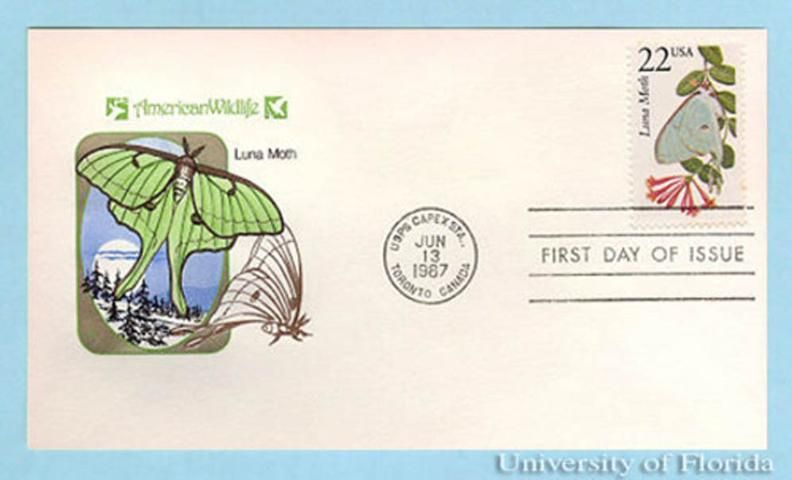
Credit: Donald W. Hall, UF/IFAS
Described and named (as Phalena plumata caudata) by Petiver in 1700, the luna moth was the first North American saturniid to be reported in the literature (Tuskes et al. 1996). The original Latin name of the luna moth, which referred to the long tails, was lost when Linnaeus converted the name to a binomial with the specific epithet luna in 1758.
The family name Saturniidae is based on the eyespots of some members of the family that contain concentric rings reminiscent of the planet Saturn (Powell 2003). The luna moth gets its name from its moon-like spots.
Distribution
Usually found in forested areas, in southern Canada it occurs from Nova Scotia to Saskatchewan. In the United States, it is found in every eastern state from Maine south to Florida and west to eastern Texas and eastern North Dakota.
Description
Adults
The adult wingspan is 75 to 105 mm (Covell 2005). Adult luna moths are large green moths with a long tail on each hind wing and discal eyespots on both the fore and hind wings (Figures 2 and 3). The luna moth is univoltine (one generation) from Michigan northward, bivoltine throughout the Ohio Valley, and trivoltine southward (Tuskes et al. 1996). In Louisiana and Florida, adults may be found during every month of the year Also, reared specimens often differ in coloration from those in nature (Ferguson 1972).
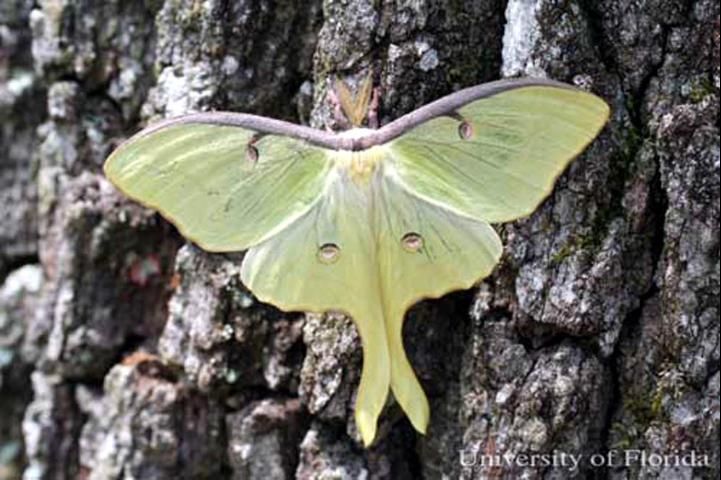
Credit: Donald W. Hall, UF/IFAS
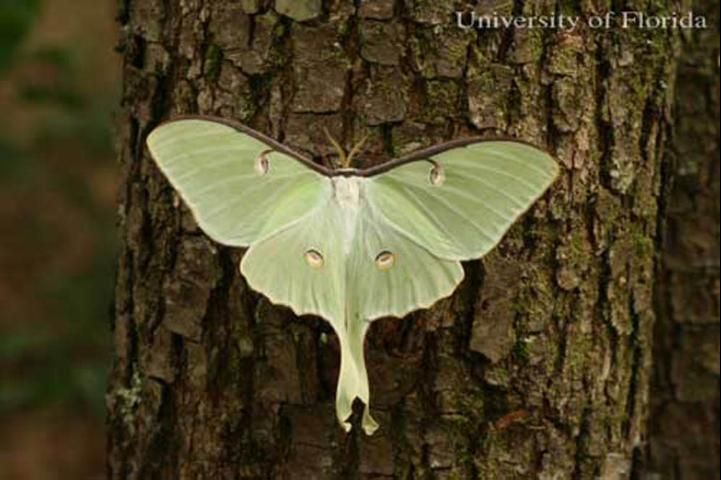
Credit: Lyle J. Buss, UF/IFAS
Adults of the spring brood in multivoltine (two or more generations) populations are typically a deeper green with reddish-purple wing margins, while those of later broods are more yellowish with yellowish margins (Packard 1914, Tuskes et al. 1996). Moths from southern populations tend to be smaller.
Luna antennae are quadripectinate (comb-like on four sides) with those of males being larger than those of females. Males are more yellowish-green while females are more blue-green in color (Packard 1914).
Eggs
The slightly oval eggs are white, mottled with the brown adhesive (Figure 4). Maximum reported dimensions in millimeters are 1.9 x 1.6 x 1.2 (length x width x height) (Peterson 1965).
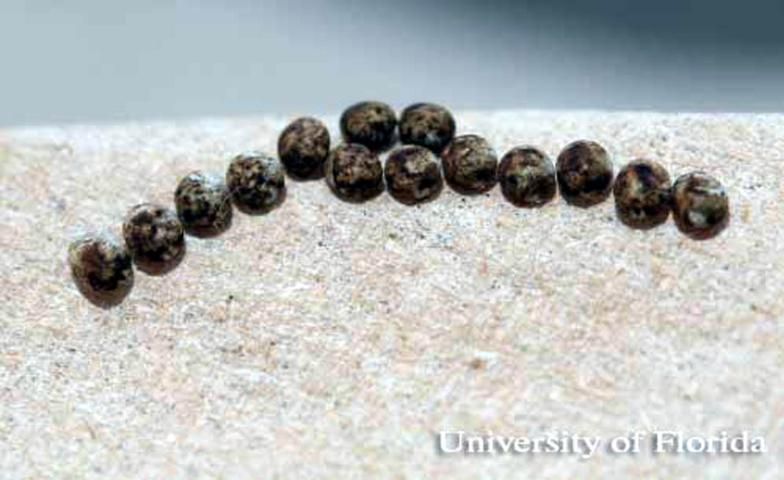
Credit: Donald W. Hall, UF/IFAS
Larvae
The bright green full-grown caterpillars are 55 to 70 mm in length (Godfrey et al. 1987). There is a yellowish-white sub-spiracular line on abdominal segments one through seven and posterior yellow lines extending across the dorsum of segments one through seven to just above the level of the spiracles. A mid-segmental transverse band of setae-bearing scoli occurs on all thoracic segments and abdominal segments one through eight. The body is sparsely covered with short, white, spatulate setae. The head varies from green to brown. Just prior to pupation, caterpillars turn a reddish color.
Early instars (Figures 5–7) differ considerably in appearance from the later instars. Packard (1914) provides color drawings and detailed descriptions of each of the five larval instars, but it should be noted that there is some variation in larvae from the same egg batch as well as considerable variation in larvae from different populations. Larvae of all instars reared by the author differ markedly in appearance from those illustrated by Packard. Some fifth instars are considerably more setiferous (hairy) than others even among siblings (Figures 9 and 10). Packard (1914) gave the following lengths for the five instars: 1st instar: 6 to 8 mm, 2nd instar: 9 to 10 mm, 3rd instar: 13 to 15 mm, 4th instar: 23 mm, 5th instar: 65 mm.
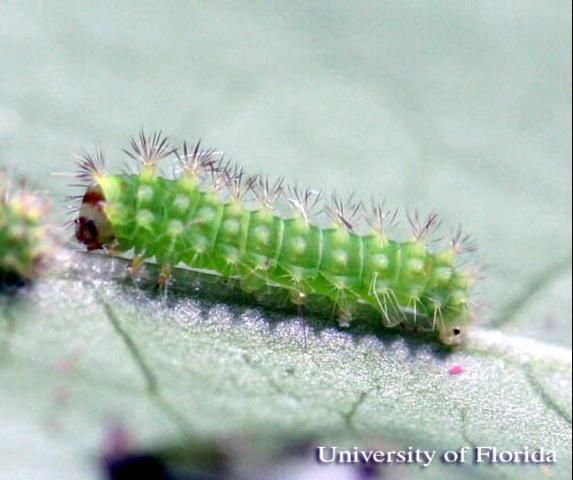
Credit: Donald W. Hall, UF/IFAS
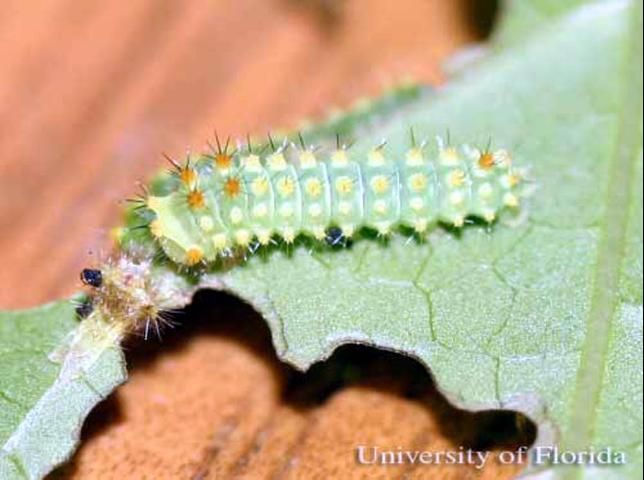
Credit: Donald W. Hall, UF/IFAS
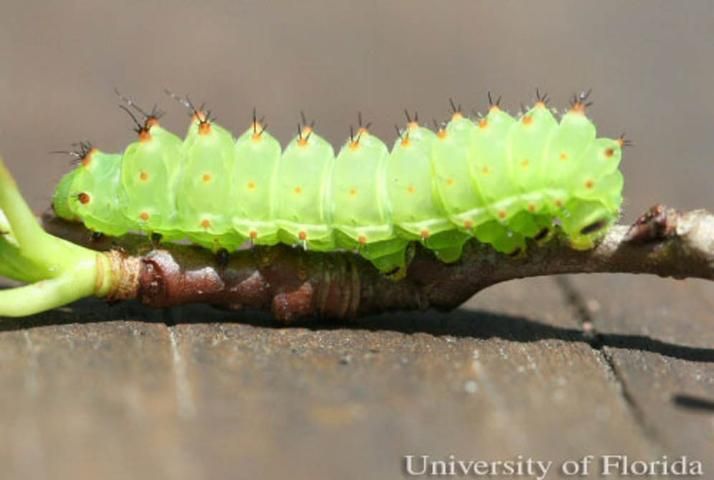
Credit: Donald W. Hall, UF/IFAS
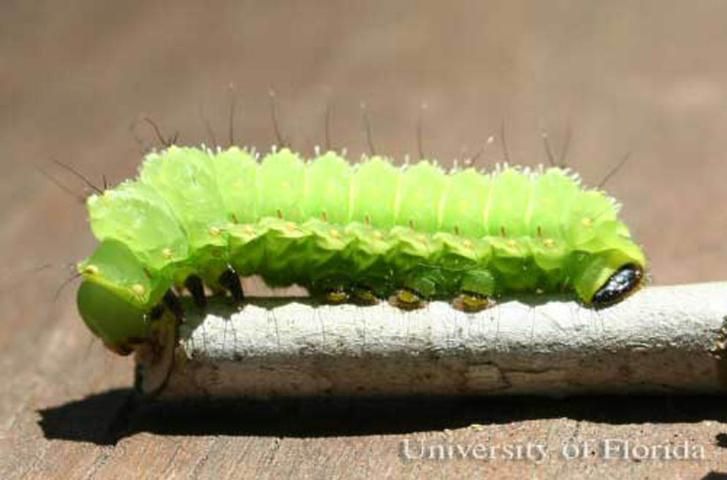
Credit: Donald W. Hall, UF/IFAS
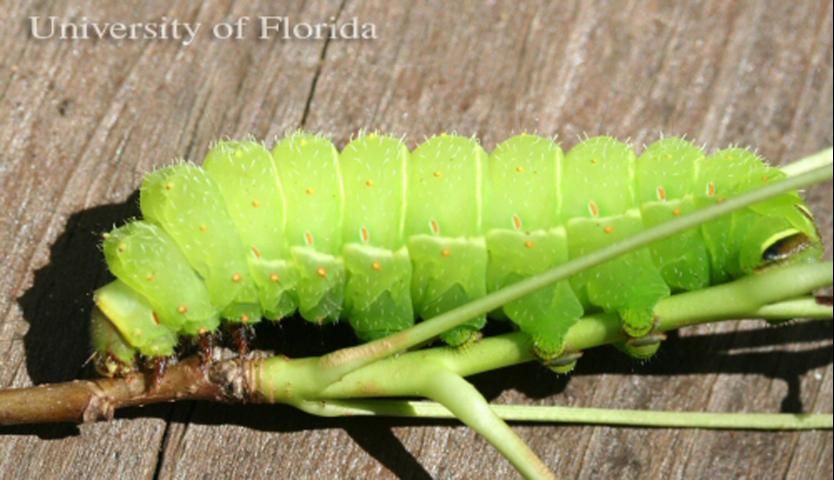
Credit: Donald W. Hall, UF/IFAS

Credit: Donald W. Hall, UF/IFAS
Cocoon and Pupa
The single-layered cocoon is wrapped in leaves (Figure 11). The dark brown, posterior end of the obtect (wings and appendages are appressed to the body—most abdominal segments are immovable) pupa (Figure 12) is anchored to a pad of silk at the rear of the cocoon by a cremaster (hooked spines) (Figure 13) which allows the adult to emerge from the pupal exoskeleton.
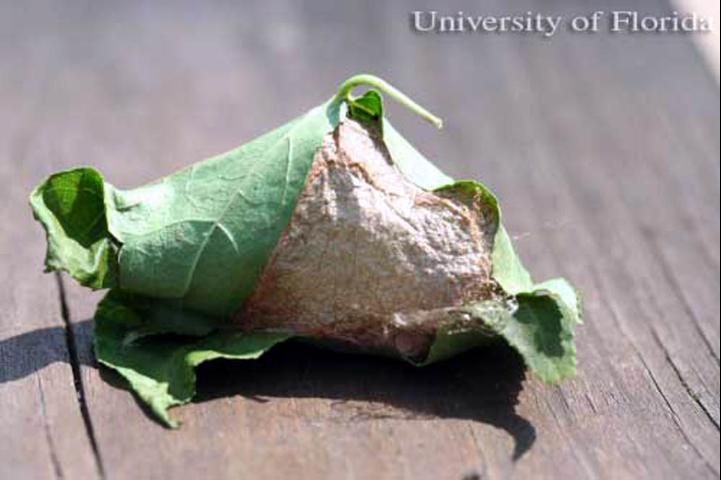
Credit: Donald W. Hall, UF/IFAS
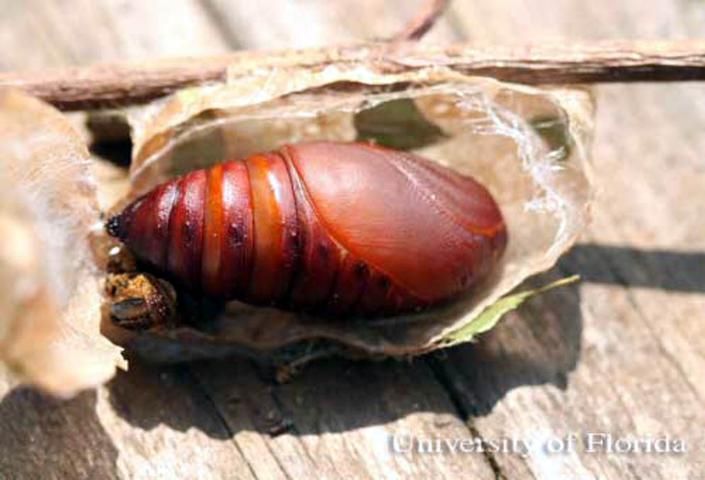
Credit: Donald W. Hall, UF/IFAS
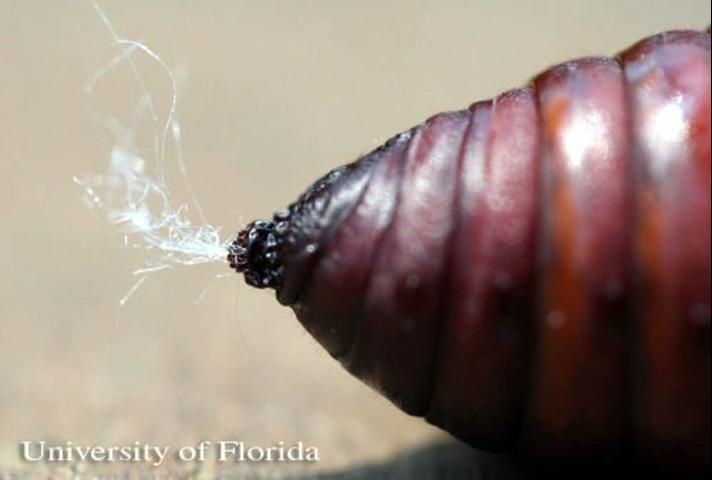
Credit: Donald W. Hall, UF/IFAS
Female pupae (Figure 14) may be distinguished from males (Figure 15) by the presence of two longitudinal notches on the ventral surface of the fourth and fifth totally exposed abdominal segments. These notches are lacking in males.

Credit: Donald W. Hall, UF/IFAS
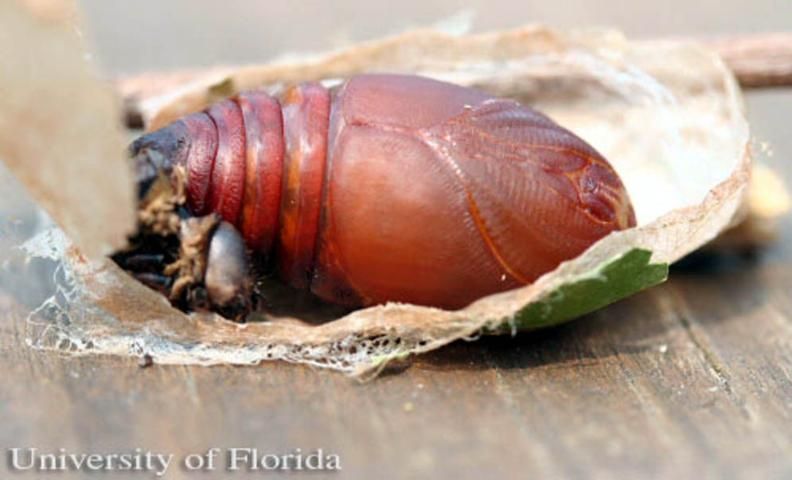
Credit: Donald W. Hall, UF/IFAS
Life Cycle and Biology
The adult moth escapes the pupal case by splitting it at the anterior end and pushing the top up (Figure 16). It then cuts its way from the cocoon (Figure 17) by the use of serrated, chitinous spurs on its thorax near the bases of the front wings (Hilton 1965, Priddle 1967).

Credit: Donald W. Hall, UF/IFAS

Credit: Donald W. Hall, UF/IFAS
Adult eclosion (emergence from pupa) typically occurs in the morning with males usually beginning emergence several days before females. Morning emergence allows time for expansion and drying of the wings prior to the evening flight period. Also, during the first day after emergence, the moth voids the reddish-colored, liquid meconium which is composed of the breakdown waste products of the old larval tissues.
The adults are strongly attracted to light—particularly UV wavelengths. There has been some concern that light pollution from man-made sources (particularly mercury vapor streetlights) may deter lunas and other silk moths from mating and have a negative impact on their populations in urban areas (Worth and Muller 1979).
Males are strong fliers and may disperse over relatively long distances. Females release a sex-attractant pheromone and may attract males from a distance. Mating usually takes place during the first couple of hours after midnight. Adults have vestigial mouthparts and do not feed. Therefore, they are short-lived. Females begin laying eggs the following evening after mating and continue for several nights (Tuskes et al. 1996). At least in captivity and probably also in nature, the eggs may be laid either singly or in small clusters.
Caterpillars are solitary (Tuskes et al. 1996) and develop through five instars. Caterpillars exposed to short photoperiods produce diapausing pupae while those exposed to long photoperiods produce non-diapausing pupae (Wright 1967).
When caterpillars are full-grown, they may begin to wander. The cocoon is spun among the leaves of the deciduous host plants but is not anchored to a twig as is the case with many polyphemus moth cocoons. Therefore, they fall to the ground in autumn (Holland 1968) as the leaves fall and are not commonly seen. Development from hatching to pupation takes a month or longer depending on temperature.
Luna moth caterpillars are never sufficiently common to cause significant damage to their host trees.
Host Plants
Broadleaf host plants belonging to a large number of genera have been reported as hosts for luna moths (Godfrey et al. 1987, Tietz 1972). However, some of the reported host plants may not be suitable for all populations of lunas. Lindroth et al. (1989) studied first instar survival, duration of larval stage, and pupal weights of caterpillars fed on eleven different plant species and found that survival was poor on some plant species that were reported in the literature as hosts. It appears that different geographical populations of luna moths are adapted to different host plants (Lindroth et al. 1989, Tuskes et al. 1996). Lindroth et al. (1989) suggested that biochemical detoxification of host defensive chemicals by caterpillar enzymes may be a factor in this host plant specialization.
Northernmost populations most often utilize white birch, Betula papyrifera Marsh, as a host. More southerly populations use a variety of host plants particularly members of the walnut family Juglandaceae (walnuts [Juglans] and hickories, [Carya] [Figure 18]), sumacs (Rhus) (Figure 19), sweetgum, Liquidambar styraciflua L. (Figure 20), and persimmon, Diospyros virginiana L. (Figure 21) (Tuskes et al. 1996). Villard (1975) lists hickory as the preferred host but recommends that rearing be done in sleeves or cages on living plants since most hickories wilt rapidly when cut. This obstacle can be overcome by diligently supplying fresh food. Sweetgum works well for captive rearing.

Credit: Donald W. Hall, UF/IFAS
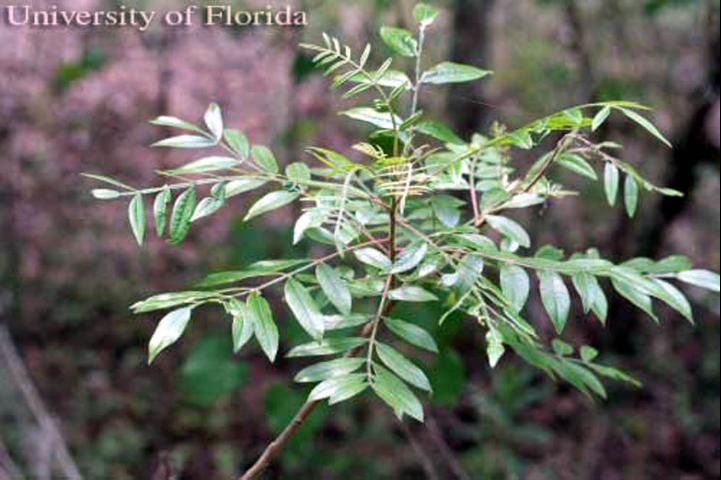
Credit: Donald W. Hall, UF/IFAS
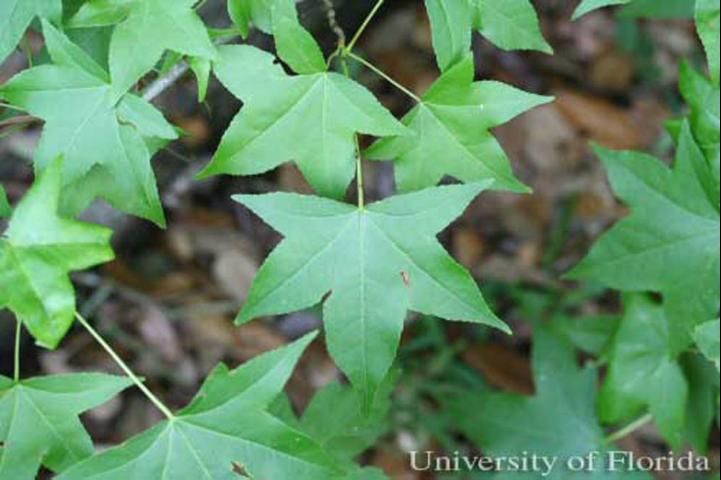
Credit: Donald W. Hall, UF/IFAS
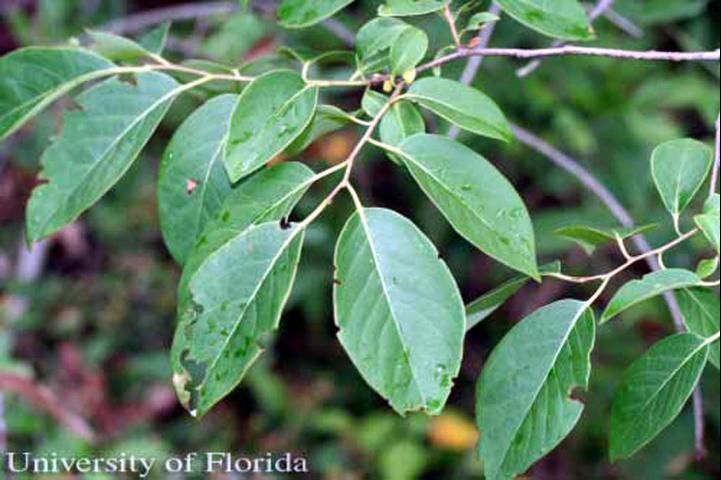
Credit: Donald W. Hall, UF/IFAS
Natural Enemies
Luna caterpillars are hosts for a number of insect parasitoids in the families Tachinidae, Ichneumonidae, and Pteromalidae (Tuskes et al. 1996, Kellog et al. 2003). All luna moth stages also are subject to predation by a variety of invertebrates and/or vertebrate predators. The adults are not even safe at night. Kellog et al. (2003) reported that the ground below an owl roost was littered with saturniid wings including those of luna moths.
Defenses
Luna caterpillars gain protection from predators by their cryptic green coloration. When threatened they often rear the front part of the body in a "sphinx" pose—possibly to make them less caterpillar-like to a predator. If attacked, luna caterpillars as well as those of many other bombycoid moths make a clicking noise with the mandibles—sometimes as a prelude to or accompanied by defensive regurgitation of distasteful fluids. Brown et al. (2007) found that ants and mice were deterred by the regurgitant of the polyphemus moth, Antheraea polyphemus (Cramer), and suggested that the clicking is a warning of the impending regurgitation.
When the adults are in flight, the twisted long tails are believed to interfere with echo-location by hunting bats (Barber et al. 2015, Lee and Moss 2016).
Selected References
Barber JR, Leavell BC, Keener AL, Breinholt JW, Chadwell BA, McClure JW, Hill GM, Kawahara AY. 2015. Moth tails divert bat attack: evolution of acoustic deflection. Proceedings of the National Academy of Sciences 112(9): 2812–2816.
Brown SG, Boettner GH, Yack JE. 2007. Clicking caterpillars: acoustic aposematism in Antheraea polyphemus and other Bombycoidea. The Journal of Experimental Biology 210: 993–1005.
Covell CV. 2005. A Field Guide to Moths of Eastern North America. Special Publication Number 12. Virginia Museum of Natural History. Martinsville, Virginia. 496 pp.
Ferguson DC. 1972. In Dominick RB, Edwards CR, Ferguson DC, Franclemont JG, Hodges RW, Munroe EG. The Moths of America North of Mexico, fasc. 20.2B, Bombycoidea (in part). EW Classey, LTD. Middlesex, England.
Godfrey GL, Jeffords M, Appleby JE. 1987. Saturniidae (Bombycoidea). In Stehr FW. Immature Insects. Kendall/Hunt Publishing Company. Dubuque, Iowa. pp. 513–521.
Hilton HO. 1965. Pupal escape mechanism of certain saturniid moths. Florida Entomologist 48: 239–24.
Holland WJ. 1968.The Moth Book: A Guide to the Moths of North America. Dover Publications, Inc. New York. (First published in 1903 by Doubleday, Page and Company. New York) 479 pp.
Kellog SK, Fink LS, Brower LP. 2003. Parasitism of native luna moths, Actias luna (L.) (Lepidoptera: Saturniidae) by the introduced Compsilura concinnata (Meigen) (Diptera: Tachinidae) in central Virginia, and their hyperparasitism by trigonalid wasps (Hymenoptera: Trigonalidae). Environmental Entomology 32: 1019–1027.
Lee W-J, Moss CF. 2016. Can the elongated hindwing tails of fluttering moths serve as false sonar targets to divert bat attacks? Journal of the Acoustical Society of America 139(5): 2579–2588.
Lindroth RL. 1989. Chemical ecology of the luna moth: Effects of host plant on detoxification enzyme activity. Journal of Chemical Ecology 15: 2019–2029.
Packard AS. 1914. Monograph of the Bombycine Moths of North America. Part 3. Memoirs of the National Academy of Science 12: 1–516.
Peterson A. 1965. Some eggs of moths among the Sphingidae, Saturniidae, and Citheroniidae (Lepidoptera). Florida Entomologist 48: 213–219.
Powell JA. 2003. Lepidoptera (Moths, Butterflies). In VH Resh, Cardé RT, editors. Encyclopedia of Insects. Elsevier Science (USA) San Diego, California. pp. 631–663.
Priddle TR. 1967. Structures employed by Actias luna (Saturniidae) in effecting emergence from the cocoon. Journal of the Lepidopterists Society 21: 249–252.
Tietz HM. 1972. An Index to the Described Life Histories, Early Stages and Hosts of the Macrolepidoptera of the Continental United States and Canada. Part 1. The Allyn Museum of Entomology. Sarasota, Florida. (Distributed by Entomological Reprint Specialists. Los Angeles, California). 536 pp.
Tuskes PM, Tuttle JP, Collins MM. 1996. The Wild Silk Moths of North America: The Natural History of the Saturniidae of the United States and Canada. Cornell University Press. Ithaca, New York. 250 pp.
Villard P. 1975. Moths and How to Rear Them. Dover Publications, Inc. New York, New York. 242 pp.
Worth BC, Muller J. 1979. Captures of large moths by an UV light trap. Journal of the Lepidopterists' Society 33: 261–264.
Wright DA. 1967. The effects of photoperiod on the initiation of pupal diapause in the wild silkworm, Actias luna. Journal of the Lepidopterists Society 21: 255–258.